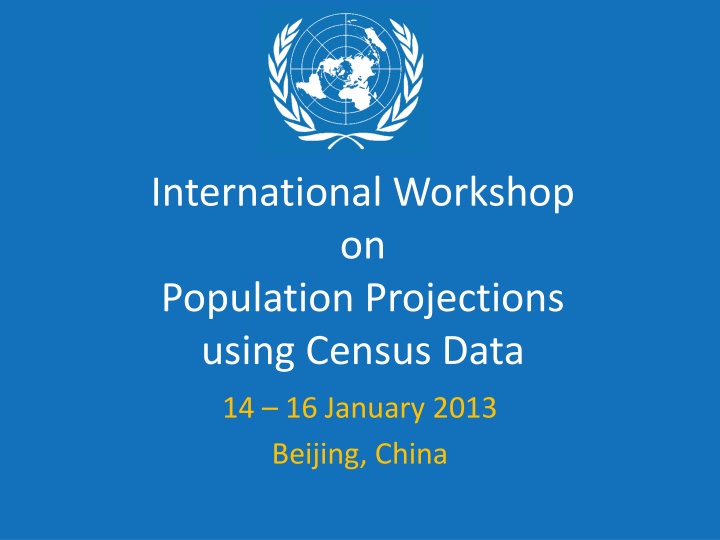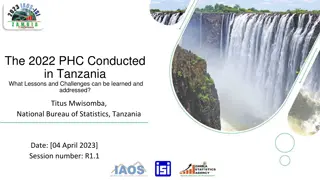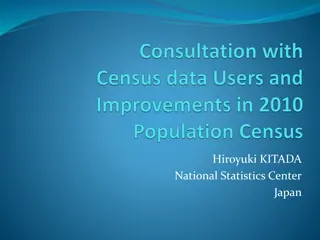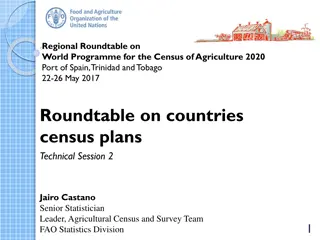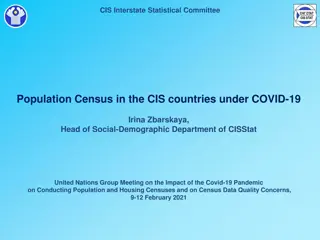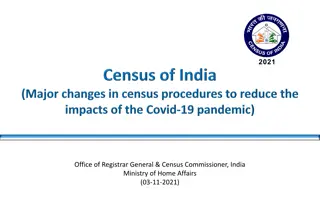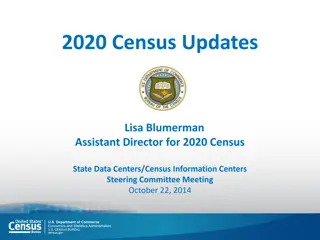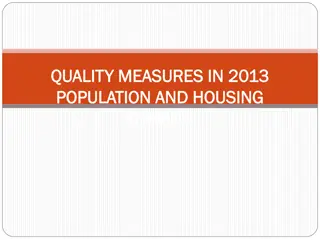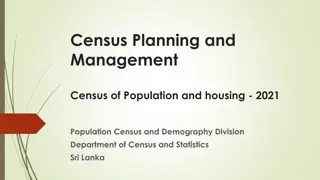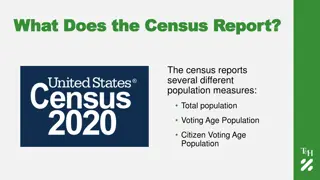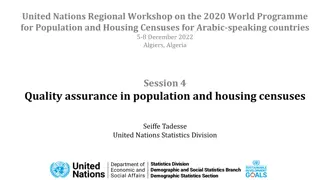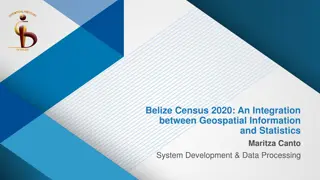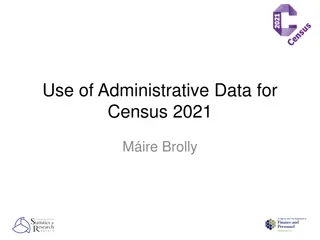International Workshop on Population Projections using Census Data
"The International Workshop on Population Projections using Census Data took place in January 2013 in Beijing, China. Participants discussed methods and challenges in projecting populations based on census data, aiming to improve accuracy and reliability of future demographic forecasts. Experts shared insights on trends and patterns to enhance understanding of population dynamics."
Download Presentation

Please find below an Image/Link to download the presentation.
The content on the website is provided AS IS for your information and personal use only. It may not be sold, licensed, or shared on other websites without obtaining consent from the author.If you encounter any issues during the download, it is possible that the publisher has removed the file from their server.
You are allowed to download the files provided on this website for personal or commercial use, subject to the condition that they are used lawfully. All files are the property of their respective owners.
The content on the website is provided AS IS for your information and personal use only. It may not be sold, licensed, or shared on other websites without obtaining consent from the author.
E N D
Presentation Transcript
International Workshop on Population Projections using Census Data 14 16 January 2013 Beijing, China
Session IV: Projecting the levels of mortality, fertility, and migration Projecting life expectancy at birth Projecting total fertility Projecting international net-migration http://unstats.un.org/unsd/demographic/meetings/wshops/China2013/list_of_docs.htm
Projecting levels of mortality Overview
Projecting levels of mortality Mortality change (and fertility change) are processes where new behavior is gradually being adopted by people. It is similar to the processes of a new product penetrating a market. In other words: A diffusion process. Diffusion processes are often modeled by a logistic function.
Projecting levels of mortality Mortality change (and fertility change) are processes where new behavior is gradually being adopted by people. It is similar to the processes of a new product penetrating a market. In other words: A diffusion process. Diffusion processes are often modeled by a logistic function.
Projecting levels of mortality The general form of a logistic function can be expressed as k =+ ( ) P t . 1 exp[ ( )] t k Saturation level or asymptote of the diffusion process Growth rate of the s-curve Length of time the curve takes to reach the midpoint of the growth trajectory. For modelling purposes, the logistic function is often simplified, with easier to interpret parameters: k = ( ) P t (81) t Ln 1 exp[ + t t ( )] m = m t tm Midpoint of the growth/diffusion process { } t Duration for the growth process to proceed from 10 per cent to 90 per cent of the ln(81) t This function relates to the general form by substituting = asymptote (k) { }
Projecting levels of mortality Logistic curve - Hypothetical increase of life expectancy 100 t=100 K=90 90 80 Life expectancy (years) 70 60 tm=80 50 40 30 0 25 50 75 100 125 150 175 200 Years
Projecting levels of mortality I: United Nations Model The demographic process of mortality and fertility decline consists of two phases: a first phase of accelerating rates of decline that is followed by a second phase of slowing rates of decline. Such a two-phase process can be modelled by two logistic functions, one approaching an upper limit and a second one that approaches a lower limit. k k = + 1 (81) t 2 (81) t ( ) P t Ln Ln 1 exp[ + t t )] 1 exp[ + t t ( ( )] 1 2 m m 1 2
Projecting levels of mortality I: United Nations Model Models of annual gains in life expectancy at birth, males Models of annual gains in life expectancy at birth, females 0.8 0.8 0.7 0.7 0.6 0.6 0.5 0.5 0.4 0.4 0.3 0.3 0.2 0.2 0.1 0.1 0.0 0.0 40 45 50 55 60 65 70 75 80 40 45 50 55 60 65 70 75 80 Very slow Slow pace Medium Pace Fast pace Very fast Very slow Slow pace Medium Pace Fast pace Very fast
Projecting levels of mortality I: United Nations Model Model trajectories of gains in life expctancy, low life expectancy, males 85 80 75 Life expectancy at birth (years) 70 65 60 55 50 45 40 35 2000 2010 2020 2030 2040 2050 2060 2070 2080 2090 2100 Year Very Slow Slow Medium Fast Very Fast
Projecting levels of mortality I: United Nations Model Model trajectories of gains in life expctancy, high life expectancy, males 95 93 91 Life expectancy at birth (years) 89 87 85 83 81 79 77 75 2000 2010 2020 2030 2040 2050 2060 2070 2080 2090 2100 Year Very Slow Slow Medium Fast Very Fast
UNPD_MorModel.xlsm 1. Enter description 2. Enter your data 2. Select a model for each sex
UNPD_MorModel.xlsm Projected life expectancy at birth 95 90 85 80 75 70 1960 1980 2000 2020 2040 2060 2080 2100 2120 Years Males Females
UNPD_MorModel.xlsm Sex differentials [Female-Male] 6.00 5.00 4.00 3.00 2.00 1.00 0.00 1960 1980 2000 2020 2040 2060 2080 2100 2120 Years F-M
Projecting level of mortality II: US Census Bureau Model The model in spreadsheet E0LGST.xls interpolates and extrapolates life expectancies at birth, by sex. The program fits a logistic function to 2 to 17 life expectancies at birth, given the upper and lower asymptotes.
E0LGST.xls Input data for E0LGST.xls Table number [ Table 123 ] Country name and Year [ Poplandia: 1960 and 1980 ] Lower asymptote [leave default] Upper asymptote [leave default] 2-17 data points of observed life expectancy Dates for life expectancy [Decimal years: 1960.5 for midyear] Values for male, female life expectancy Sex ratio at birth [male births per female births] Start year for listing results Sources of input data
E0LGST.xls 1. Enter description 2. Enter observed life expectancies 3. Enter parameter 4. Retrieve projection (Automatic update)
E0LGST.xls COUNTRY: YEARS 1. Life Expectancy by Sex 90 85 80 75 70 65 60 55 50 1940 1960 1980 2000 2020 2040 2060 2080 Male Female
E0LGST.xls COUNTRY: YEARS 2. Sex Differential in Life Expectancy 7.00 6.50 6.00 5.50 5.00 4.50 4.00 1940 1960 1980 2000 2020 2040 2060 2080
Hands-on exercise: Mortality Make yourself familiar with the Excel templates E0LGST.xls [USBC] UNPD_MorModel.xls/UNPD_MorModel.xlsm [UNPD] Prepare a projection using a target level of life expectancy or a typical rate of change. Validity check I: Sex-differentials in e0
Hands-on exercise: Mortality Validity check II: Explore ways to ensure that the projected trends are compatible with past trends.
Projecting levels of fertility Overview
Projecting levels of fertility I: United Nation Model Applies a similar model as for mortality. Not the level itself, but the rates of changes are modeled Incorporates the observation that during the demographic transition, fertility first changed slowly, then accelerated and finally decelerated
UNPD_FerModel.xls 1. Enter description 2. Enter data 3. Select a model
UNPD_FerModel.xls Projected TFR 7.0 6.0 5.0 4.0 3.0 2.0 1.0 0.0 2000 2010 2020 2030 2040 2050 2060 2070 2080 2090 2100 2110
Projecting level of fertility II: US Census Bureau Model The model in spreadsheet TFRLGSTNew.xls interpolates and extrapolates Total Fertility Rates (TFR). The program fits a logistic function to 2 to 17 TFRs, given the upper and lower asymptotes.
TFRLGSTNew.xls Input data for TFRLGSTNew.xls Table number [ Table 123 ] Country name and Year [ Poplandia: 1960 and 1980 ] Lower asymptote [leave default] Upper asymptote [leave default] 2-17 data points of observed TFR Reference dates for TFR [Decimal years: 1960.5 for midyear] Values for TFR Start year for listing results Sources of input data
TFRLGSTNew.xls 1. Enter description 2. Enter observed TFR 3. Enter parameter 4. Retrieve projection (Automatic update)
TFRLGST.xls COUNTRY: YEARS 1. Total Fertility Rates 7.00 6.50 6.00 5.50 5.00 Total fertility rate 4.50 4.00 3.50 3.00 2.50 2.00 1940 1960 1980 2000 2020 2040 2060 2080 Year
TFRLGSTNew.xls COUNTRY: YEARS 2. Input/Output TFR's 7.00 6.50 6.00 5.50 5.00 4.50 4.00 3.50 3.00 2.50 2.00 1955.0 1960.0 1965.0 1970.0 1975.0 1980.0 1985.0 1990.0 1995.0 Reported Logistic
Hands-on exercise: Fertility Make yourself familiar with the Excel templates TFRLGST.xls [USBC] UNPD_FerModel.xls/UNPD_FerModel.xlsm [UNPD] Prepare a projection using a target level of Total Fertility or a typical rate of change. Validity check I: Explore ways to ensure that the projected trends are compatible with past trends.
Projecting levels of Migration Overview
Projecting levels of Migration International migration is the most challenging part of a population projection exercise: Reliable data on the number of immigrants and emigrants are often not available Migration exhibits strong fluctuations that make extrapolations difficult, if not untenable. Not possible to calculate meaningful demographic rates (exposure/occurrence rates) for immigration and net migration. International (net) migration is often formulated in terms of absolute numbers. Because if its irregular fluctuations, (net) migration is often kept constant over time.
Excursion: Test data Spectrum comes with a complete database of national estimates and projections for all countries (WPP2010). The data are formatted into time series for single years, and into single years of age. How to obtain the data?
Spectrum: Step 7.2 Copy to clipboard Paste into Excel Transpose, if necessary
